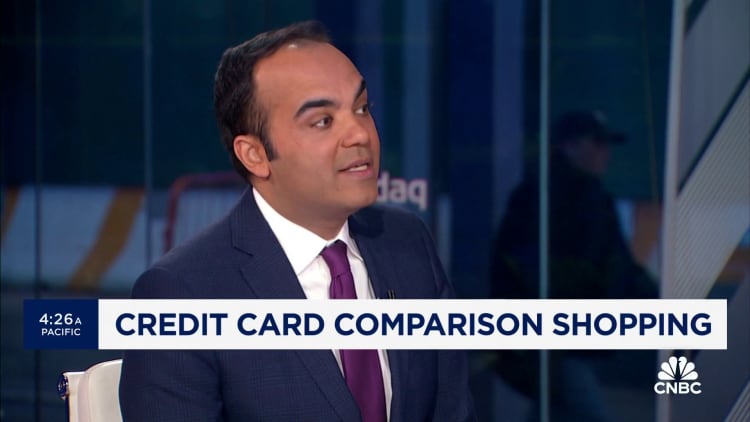Olga Rolenko | Moment | Getty Images
The nation’s largest credit card companies typically charge higher interest rates than small banks and credit unions â and switching may save the average cardholder hundreds of dollars a year, according to an analysis issued Friday by the Consumer Financial Protection Bureau.
However, some consumers, depending on their card and use, may get a bigger financial benefit by sticking with large lenders, experts said.
More from Personal Finance:
Average credit card balances jump 10% to a record high
Here’s how to spot ‘shrinkflation’
New student loan plan may make it easier to become a homeowner
In the first half of 2023, the largest U.S. lenders charged a typical credit card annual percentage rate that was 8 to 10 percentage points greater than that of smaller lenders, according to the financial watchdog.
Rates for consumer debt, and savings, products have risen as the U.S. Federal Reserve has raised its benchmark interest rate. The CFPB analysis captures all but the most recent increase, a quarter-point hike in July.
Consumers with a $5,000 balance can save $400 to $500 a year by using cards from small versus large lenders, according to the CFPB analysis, which said the “stakes are high” for cardholders. The average person has a balance of $6,360, according to TransUnion.
“We’re finding many of them would be better off with newer entrants or smaller players in the market,” CFPB Director Rohit Chopra said Friday during an appearance on CNBC’s “Squawk Box.” “For the average household … switching can actually save them hundreds and hundreds of dollars over the course of the year.”
Card balances and total debt are at all-time highs
The agency’s findings come as average credit card balances and total credit card debt hit all-time highs at the end of 2023. The average credit card interest rate for all accountholders was more than 21% in November, also a record, according to Federal Reserve data.
The federal agency’s analysis defines large lenders as the nation’s 25 biggest, and small lenders as all others in its sample. Its data is based on 643 general-purpose credit cards offered across 156 total issuers, including 84 banks and 72 credit unions.

Large lenders account for the vast majority of the credit card market: The 10 biggest have 83% market share and the top 30 have roughly 95%, according to another recent CFPB report.
The credit-card market is highly competitive and gives consumers a broad range of cards from which to choose, said spokespeople for the Consumer Bankers Association and American Bankers Association, trade groups representing banks and lenders.
“Sometimes a consumer just wants a drive-thru hamburger. Sometimes a consumer wants a steak. A thriving marketplace means that consumers can choose products that may have different prices and offer features, perks, or other value that’s specific to them,” Lindsey Johnson, CEO of the Consumer Bankers Association, said in a written statement.
Credit scores didn’t impact findings
The CFPB’s new interest-rate findings are consistent regardless of a consumer’s credit score, it said.   Â
For example, someone with “poor” credit (a credit score of 619 or less) had a median 20.62% average percentage rate at a small institution versus 28.49% at a large one, according to CFPB data. Likewise, small lenders charged a median 15.24% rate for someone with “great” credit, compared with 22.99% for large firms.
One caveat: By law, federal credit unions â which fall in the small-lender category â can’t charge interest rates exceeding 18% APR. Even excluding credit unions, however, small issuers tend to have lower APRs than larger ones, CFPB said.
And this isn’t to suggest that an 18% rate is good for consumers: That would still fall into the bucket of high-interest debt, said Ted Rossman, industry analyst at CreditCards.com.
Why interest rates may not matter for some users
The CFPB report doesn’t necessarily offer a complete picture of the credit card market, Rossman said.
For one, interest rates are only an issue for cardholders who don’t pay their bill in full and on time each month, i.e., those who carry a credit card balance from month to month, he said.
About half â 51% â of cardholders didn’t carry a monthly balance as of November, according to Bankrate. Their accounts don’t accrue interest. That share is down from 61% in 2021, however.
“It’s not that [the interest rate] doesn’t matter ever, but it doesn’t matter as long as you’re paying in full,” Rossman said.
We’re finding many of them would be better off with newer entrants or smaller players in the market.
Rohit Chopra
CFPB director
Large lenders also tend to offer more generous rewards programs such as cash back on purchases or perks related to travel and other categories, for example, Rossman said.
While large issuers tend to charge higher annual fees, those fees may be worthwhile for users whose rewards value exceeds their annual fee and who use their cards responsibly, Rossman said. Consumers may still “come out way ahead” via card benefits received for purchases they’d planned to make anyway, he said.
To that point, 27% of the credit cards issued by large firms charge an annual fee, versus 9.5% of those from small firms, the CFPB found. Large institutions’ average annual fees for those cards were also higher: $157 versus $94, respectively.

Further, while small issuers tend to charge lower APRs on an ongoing basis, large lenders may offer promotions for temporary 0% interest on balance transfers from existing cards, for example. These promotions, when used appropriately, can perhaps help users pay off high-interest card debt, Rossman said.
Ultimately, cardholders who carry a balance may be best served by avoiding use of credit cards altogether: Try to stick to cash or debit as you pay down your existing card balance, perhaps with the help of a nonprofit credit counselor, he said.
“I’d be hard-pressed to find a case where even an 8%, 10% or 12% card makes sense for them,” Rossman said.

